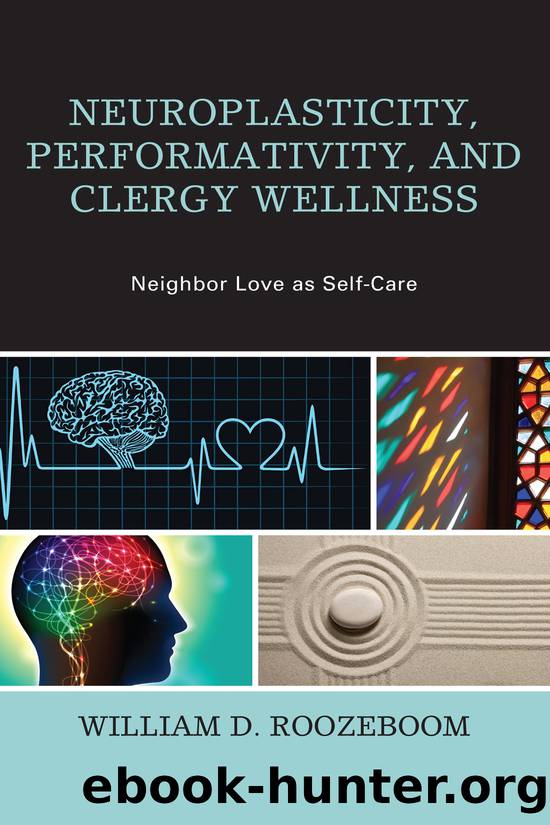Neuroplasticity, Performativity, and Clergy Wellness by Roozeboom William D.;

Author:Roozeboom, William D.;
Language: eng
Format: epub
Publisher: Lexington Books/Fortress Academic
Chapter 4
Performativity and Plasticity
Storying Self Bi-directionally in the Embodied Brain Ecosystem
The idea that activity might change the heart or muscles is seldom questioned. The possibility that behavior could change the structure and function of the brain is seldom considered (Kolb, 1995, p. 5)
Human beings are meaning seekers and makers. As we encounter ourselves, others, and the world, we make sense of our experience by weaving together the events into a coherent narrative, a story. Furthermore, within the social constructionist, narrative theory, âstoryingâ is not simply telling stories about oneâs life, rather âstoryingâ constructs oneâs life (White & Epston, 1990; Freedman & Combs, 1996; Monk, Windslade, Crocket, & Epston, 1997). We live into the stories we tell and that are told about/around us.
Often, particularly in persons who seek help from mental health professionals and spiritual caregivers, the story of self (oneâs identity) has become âproblem-saturatedâ and âpathologized.â What this means is that individuals tend to focus exclusively on the negative aspect(s) of their experience and adopt limiting labels based on the cultural milieu of the medical model, which seeks to provide a precise diagnosis and treatment for an ailment (Goldstein, 2002; De Jong & Kim Berg, 2008). The medical model arose out of impressive achievements in the late 19th and early 20th centuries as scientific discoveries made it possible to diagnose, treat, and prevent life-threatening diseases (De Jong & Kim Berg, 2008, p. 6). One of the most significant discoveries found during this time period was the link between bacteria and contagious disease by Louis Pasteur. In light of this research, physicians sought to help patients by diagnosing which diseases were causing their symptoms and then administering appropriate treatments (Ibid.). This was quite successful and the mortality rates for diseases like tuberculosis, cholera, tetanus, diphtheria, and typhoid were greatly reduced. Consequently, a new model for clinical practice of all forms was introducedâdiagnose to seek out root causes and treat appropriately. This âmedical modelâ continues to be the dominant framework for biological and mental health care (and often spiritual health care as well).
The diagnosis for root cause mentality becomes naïve, limiting, and often shaming for complex, particular persons in the postmodern milieu. Often, persons and medical professionals (and clergy) focus exclusively on one aspect of their own, or a careseekerâs, problematic experience, label it, and ignore contradictory layers of identity and experience that do not fit the problem story. The person and the story thus become problem-saturated. Narrative therapy seeks to expose the inherent bias of problem-saturation through externalization1 and help individuals see the other layers of their identity. Initially, the contradictory layers are âabsent, but implicitâ life-giving layers of a personâs story and thus are ignored, denied, or downplayed (White, 2007). Narrative theory reminds us that no single layer of oneâs identity is all-encompassing; rather, persons are complex, multilayered, multi storied beings. When individuals get in touch with these absent stories, reclaim them, and reauthor and story them as part of a preferred future, they literally construct a new identity of self.
Download
This site does not store any files on its server. We only index and link to content provided by other sites. Please contact the content providers to delete copyright contents if any and email us, we'll remove relevant links or contents immediately.
Fangirl by Rainbow Rowell(7855)
How to Bang a Billionaire by Alexis Hall(7426)
Wonder by R. J. Palacio(7091)
The Space Between by Michelle L. Teichman(6105)
The Thirst by Nesbo Jo(5809)
Assassin’s Fate by Robin Hobb(5263)
Wiseguy by Nicholas Pileggi(4616)
The Kite Runner by Khaled Hosseini(4493)
The Night Circus by Erin Morgenstern(4446)
Bittersweet (True North #1) by Sarina Bowen(4348)
Paper Towns by Green John(4183)
Gerald's Game by Stephen King(3936)
Too Much and Not the Mood by Durga Chew-Bose(3705)
Pillow Thoughts by Courtney Peppernell(3432)
Twelve Days of Christmas by Debbie Macomber(3034)
Goodbye Paradise(2987)
Good by S. Walden(2926)
The Rosie Effect by Graeme Simsion(2722)
After We Fell by Anna Todd(2661)
